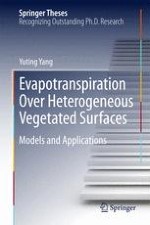2015 | Buch
Über dieses Buch
The focus of this work is the development of models to estimate evapotranspiration (ET), investigating the partitioning between soil evaporation and plant transpiration at field and regional scales, and calculating ET over heterogeneous vegetated surfaces. Different algorithms with varying complexities as well as spatial and temporal resolutions are developed to estimate evapotranspiration from different data inputs. The author proposes a novel approach to estimate ET from remote sensing by exploiting the linkage between water and carbon cycles. At the field scale, a hybrid dual source model (H-D model) is proposed. It is verified with field observations over four different ecosystems and coupled with a soil water and heat transfer model, to simulate water and heat transfer in the soil-plant-atmosphere continuum. At the regional scale, a hybrid dual source scheme and trapezoid framework based ET model (HTEM), using remote sensing images is developed. This model is verified with data from the USA and China and the impact of agricultural water-saving on ET of different land use types is analyzed, in these chapters. The author discusses the potential of using a remote sensing ET model in the real management of water resources in a large irrigation district. This work would be of particular interest to any hydrologist or micro-meteorologist who works on ET estimation and it will also appeal to the ecologist who works on the coupled water and carbon cycles. Land evapotranspiration is an important research topic in hydrology, meteorology, ecology and agricultural sciences.
Dr. Yuting Yang works at the CSIRO Land and Water, Canberra, Australia.
Anzeige
